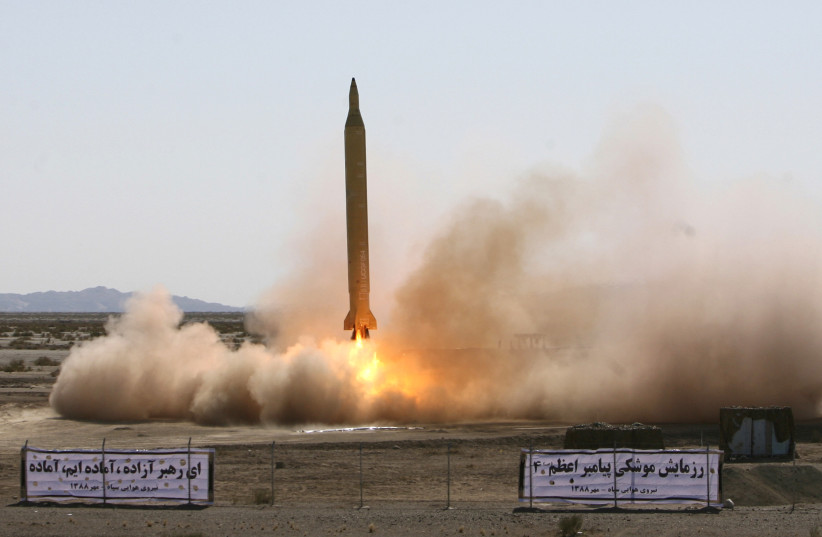Tal Inbar: Recent launch was Iran signaling its missile program is off the table for Iran deal discussions

Iran launched a new satellite-carrying rocket recently, according to reports on February 3.
Forbes has reported that it could carry a nuclear warhead, while other media have pointed out that the launch was done as the new Biden administration is discussing the Iran deal.
The importance of the launch looks to be multilayered, both signaling to the US the power of Iran’s missile program, and also potentially threatening Israel.
Tal Inbar was the head of the UAV research center at the Fisher Institute for Air and Space Strategic Studies until 2019, and he is an independent analyst on missiles, UAV and space. He frequently covers new Iranian missile technology.
“This is an important development,” he told The Jerusalem Post in an interview. Iran introduced a totally new launch vehicle, according to Inbar. “We knew about it from Iranian sources more than a year ago, and it was fired and launched without a satellite as a test flight, and it is a three-stage launch vehicle.”
It is called Zoljanah.
Zoljanah – new Iranian SLV is about to be officially revealed today. The picture released already shows the interstate section and the second stage, on the gantry tower at the circular launch pad (Semnan). Taller than Safir SLV, a combining Liquid and Solid propulsion. pic.twitter.com/vCoCV8DAKi
— Tal Inbar (@inbarspace) February 1, 2021
What is interesting is that the first and second stages of the missile use solid fuel. They are 1.5 m. in diameter, and this is the largest solid rocket in Iran’s arsenal. The rocket, or SLV (Satellite Launch Vehicle), is a new revelation, says Inbar.
It comes amid all the press coverage of Iranian threats, including to Israel, and the discussion surrounding Washington rejoining the Iran deal. Indications point to Washington hesitating before bending to Iran’s demands. Israel has warned Iran about its continued quest for nuclear weapons. Iran has warned Israel not to attack.
“It is not only a genuine test flight of a satellite vehicle, but a signal to the US, Europe and Israel that missile technology is off the table,” said Inbar.
The big question is whether it has potential as a satellite launch vehicle. What does it mean in long-range ballistic missiles? Inbar wondered. It is not an ICBM (intercontinental ballistic missile), he points out, but it could deliver high explosives several thousand kilometers. Using solid propellant is also important because it means the time needed to roll it out and prepare it for launch is minimal.
There are questions about what kind of transporter erector launcher (TEL) it might be moved on. Iran has in the past showcased TELs of varying sizes.
Iran has an extensive rocket program and numerous long-range and precision missiles which include the Shahab 3, Sejjil, the Ghadr, Fateh 110 and Qiam.
Iran also showed for the first time some official renderings of future launch vehicles which will be much bigger and heavier.
Additionally, the Islamic Republic has a plan to produce a satellite launch vehicle of 2.5 tons, says Inbar.
Iran launched a military satellite last year and may try to put another satellite into geosynchronous orbit in the future.
“We will have to wait and see future trends, because Iran has become more advanced in the field of solid propulsion, for example, steerable and movable nozzles and composite material.”
Inbar also pointed out that the US didn’t mention the recent test, contrasting it with how the US often critiques major missile tests in North Korea. North Korea is rumored to work with Iran on rocket technology and has recently revealed its own mega-missiles.
Another issue of importance is to pay attention to who is running the tests in Iran. In the past the IRGC played a key role, but the Space Agency was involved in the recent test. Last year a major missile test included a missile with both solid and liquid fuel. Several weeks ago Iran also had its Great Prophet military drill where it launched a number of missiles.
Why does liquid or solid fuel matter?
Inbar noted that many Russian and North Korean large missiles are liquid-fueled. Rockets aimed for space have liquid fuel. Liquid fuel has become more efficient in recent years. Countries like Ukraine and China also have expertise in these types of rocket engines.
Today, “you see a transition of medium range in North Korea from liquid to solid because of operational advantages; you can launch them with no preparation and do salvos, so the trend is moving in both directions, depending on the purpose of the missile,” Inbar explained.
China’s new generation of missiles, for instance, are solid propulsion.
It remains to be seen what comes next with Iran’s missile program.
As reported by The Jerusalem Post
